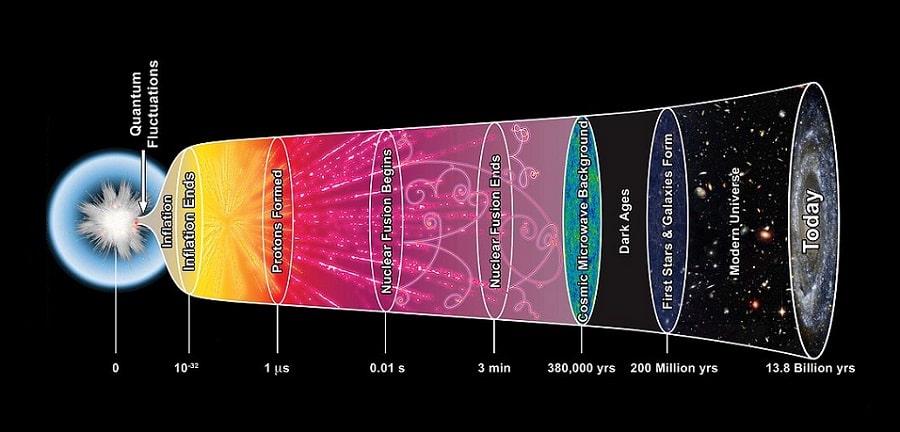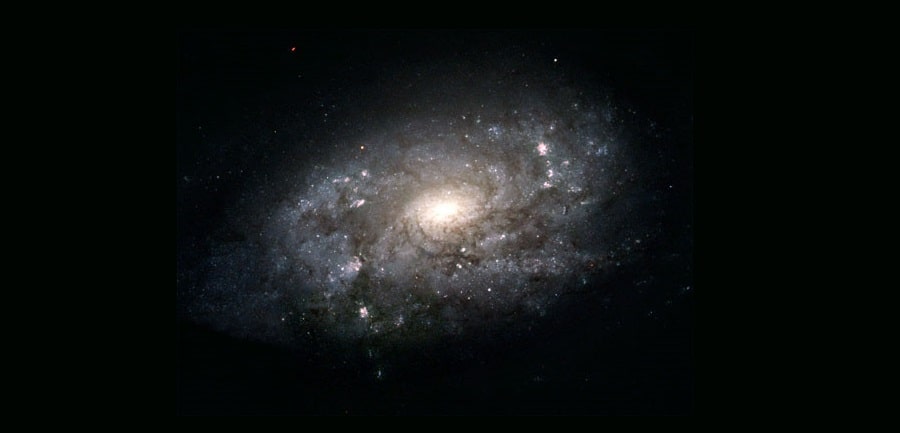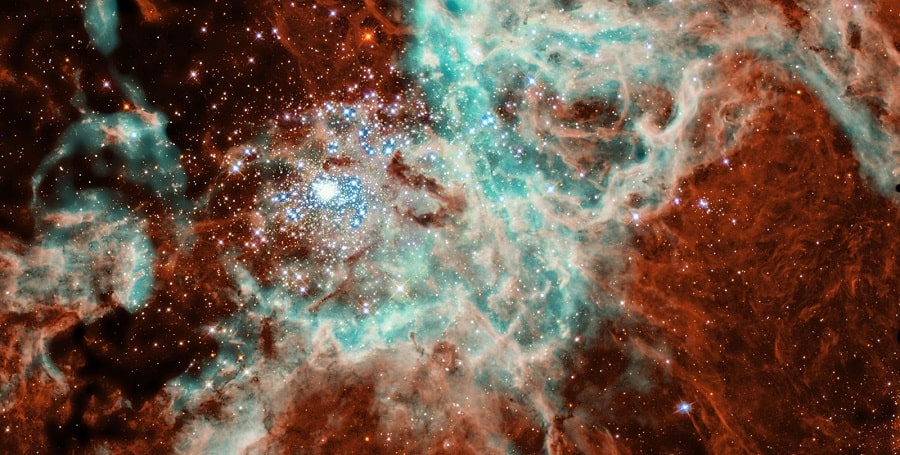March 18, 2019
Origin of the Universe, Galaxies, Stars & Planets
Contents
Early Theories
- One of the earlier theory about origin of the Universe was by German philosopher Immanuel Kant.
- Mathematician Laplace revised it in 1796.
- It is known as Nebular Hypothesis.
- The hypothesis considered that the planets were formed out of a cloud of material associated with a youthful sun

Modern Theories of Origin of the Universe
Big Bang Theory
- The most popular argument regarding the origin of the universe is the Big Bang Theory.
- It is also called expanding universe hypothesis.
- In the beginning, all matter forming the universe existed in one place in the form of a “tiny ball”
- At the Big Bang the “tiny ball” exploded violently.
- It is now generally accepted that the event of big bang took place 13.7 billion years before.
- The expansion continues even to the present day.
- As it grew, some energy was converted into matter
- As time passes, galaxies move further and further apart.
- Edwin Hubble, in 1920, provided evidence that the universe is expanding.
Steady State Theory
- The steady state theory was governed by Hermann Boudi and Thomas Gold.
- It is also known as theory of continuous creation.
- According to this theory universe has always existed and will always exist and will always look essentially the same
- So there is no overall evolution thus balancing the average density despite the expansion.
- As old galaxies move apart the new galaxies are being formed.
Oscillating Universe Theory
- This theory was advocated by Dr. Alan Sandage.
- This theory postulates that the universe not only expands but it also contracts.
- The time interval between the two phases is presumed to be billions of years.
- It is a mixture of both Big Bang a Big Crunch theory.
Galaxies
- A galaxy is a huge mass of stars nebulae, and inter-stellar material
- Galaxies are the major building blocks of the universe.
Regular Galaxies
- The regular galaxies may be of either spiral or elliptical bi shape.
Spiral Galaxies
- It is disc-shaped with greater concentration of stars near their centers.
- The Milky Way and the Great Galaxy in Andromeda are examples of large spiral galaxies
Elliptical Galaxies
- These are generally smaller than the spiral galaxies.
- They are generally symmetrical or spheroidal shape with no obvious structure.
- Most of their member stars are very old and no new star forming in them.
- Sonic of them are so small that the term ‘dwarf has been applied.
Irregular Galaxies
- Irregular galaxies get their odd shapes in many ways.
- One way irregular galaxies are formed is when galaxies collide or come close to one another, and their gravitational forces interact.
- Another source of irregular galaxies may be very young galaxies that have not yet reached a symmetrical state.

Famous Galaxies
Milky Way
- Milky Way is the galaxy that contains our Solar System.
- Solar System is located within the disk, 26,490 light-years from the Galactic Center, on the inner edge of the Orion Arm, one of the spiral-shaped concentrations of gas and dust
- The Milky Way as a whole is moving at a velocity of approximately 600 km per second with respect to extragalactic frames of reference.
- The rotational period is about 240 million years at the position of the Sun
- Milky Way has several satellite galaxies and is part of the Local Group of galaxies, which form part of the Virgo Super cluster, which is itself a component of the Laniakea Supercluster.
- Milky Way contains between 200 and 400 billion stars
Canis Majo
- The Closest galaxy is the recently discovered Canis Major dwarf galaxy, which is 25,000 light-years away.
Andromeda Galaxy
- Andromeda galaxy is the nearest galaxy to the Earth apart from smaller companion galaxies.
- It is at a distance of about 2.5 million light years.
IC 1101
- IC 1101 is the single largest galaxy that has ever been found in the observable universe.
- It has a mass of about 100 trillion stars.
NebuIa
- A nebula is a cloud of dust and gas inside a galaxy.
- Stars are born from nebula cloud
- Nebulae become visible if the gas glows or if the cloud reflects straight or obscures light from distant objects.

Star Formation
- Starts to form by accumulation of hydrogen gas in the form Nebula cloud.
- Cloud slowly shrinks and then starts to collapse onto a number of points (or cores) within the cloud, due to the pull of gravity.
- Right in the middle of these cores, it can get very hot and dense.
- When this happens, nuclear fusion can start and a star is born.
- This is called stellar ignition.
- Lifetime of a star depends very much on its size.
- Massive stars burn their fuel much faster
- Smaller stars, like Sun burn their fuel slowly and last billions of years
- Small stars will undergo a relatively peaceful death
- It will go through a planetary nebula phase to become a white dwarf
- Then it cools down over time leaving a brown dwarf.
- Massive stars, will experience a violent end called a supernova.
- Once the dust clears, the only thing remaining will be a very dense star known as a neutron star, these can often be rapidly spinning and are known as pulsars.
- If the star which explodes is larger than 4 solar masses, it can form a black hole.
Dwarfs
- Small stars less than 1.4 solar masses became Dwarf stars.
- It became extremely small in size like planet with very high densities
- Their densities may be a million times that of water.
- The matter in this state is called ‘degenerate matter’.
Chandrashekhar Limit
- Chandrasekhar Limit of 1.4 solar masses, is the theoretical maximum mass for a stable white dwarf star can have
- Stars with mass higher than the Chandrasekhar limit ultimately collapse under their own weight and become neutron stars or black holes.
Supernova
- The point of light is the explosion of a star that has reached the end of its life, known as a supernova.
- Supernovae can briefly outshine entire galaxies and radiate more energy than our sun will in its entire lifetime.
- They’re also the primary source of heavy elements in the universe
Neutron Star
- Massive stars with 1.4 to 3 solar masses became Neutron star after supernova.
- Its hyper dense, composed almost entirely of neutrons.
- A sub-class of neutron stars is called pulsars.
- Pulsars emit regular pulses of electromagnetic radiations.
- Pulsars spin very rapidly.
Black Hole
- Massive stars with more than 3 solar masses became black hole after supernova.
- It is a region of space-time exhibiting such strong gravitational effects that nothing – not even particles and electromagnetic radiation such as light – can escape from inside it.
- The term “black hole” coined in the mid-60s by US physicist John Archibald Wheeler
- 1st photo of a black hole taken from ‘Messier 87’ supergiant elliptical galaxy in the constellation Virgo
- Photos taken by ‘Event Horizon Telescope’
- The boundary of a black hole is called Event Horizon.
Quasar
- A Quasi-Stellar Radio Source is a very energetic and distant active galactic nucleus.
- Quasars are extremely luminous.
- Most large galaxies contain a supermassive central black hole.
- Quasars contain massive black holes and may represent a stage in the evolution of some galaxies
Famous Stars
Sirius A
- It also known as the Dog Star, is the brightest star in Earth’s night sky.
Proxima Centauri
- It is the nearest from earth about 4.22 light-years.
- Sun’s nearest neighbor, Alpha Centauri, is actually a triple-star system —three stars bound together by gravity.
- Alpha Centauri A and B are two bright, closely orbiting stars with a distant, dim companion, Proxima Centauri.
Units of Measurement
Astronomical Unit (AU)
- It is the average distance between Earth and the Sun, which is about 93 million miles or 150 million kilometers.
- Astronomical units are usually used to measure distances within our Solar System.
Light Year
- It is a measure of distance.
- Light travels at a speed of 300,000 km/second.
- Considering this, the distances the light will travel in one year is taken to be one light year
Parsec
- It is a unit of length used to measure large distances to astronomical objects
- One parsec is equal to about 3.26 light-years in length.
- A parsec is defined as the distance at which one astronomical unit subtends an angle of one arcsecond
Arc-seconds
- Angular measure of an object is usually expressed in degrees, arc-minutes or arc-seconds.
- A degree is divided into 60 arc-minutes and an arc-minute is divided into 60 arc-seconds.
Formation of Planets
- The stars are localized lumps of gas within a nebula.
- The gravitational force within the lumps leads to the formation of a core to the gas cloud and a huge rotating disc of gas and dust develops around the gas core.
- In the next stage, the gas cloud starts getting condensed
- Matters around the core develops into small-rounded objects.
- It develop into planetesimals.
- Planetesimals are a large number of smaller bodies.
- Larger bodies start forming by collision, and gravitational attraction causes the material to stick together.
- In the final stage, these large number of small planetesimals accrete to form a fewer large bodies in the form of planets


